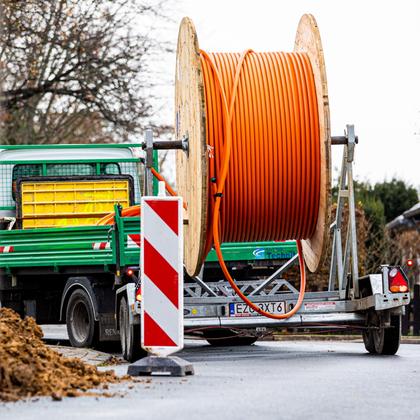Status: 04/13/2023 11:24 am
The expansion of the fiber optic network in Germany is progressing slowly, despite high funding amounts. Competitors accuse Deutsche Telekom of slowing down expansion through its business practices.
Competitors accuse Deutsche Telekom of obstructing fiber optic expansion in Germany. In a fire letter to Digital Minister Volker Wissing (FDP), the companies complain that Telekom is using “strategic maneuvers” to slow down fiber optic expansion and thus endanger the federal government’s broadband goals.
There is an allegation that Telekom is planning or building lines even though it has access to the lines of the competition. From the point of view of the broadband associations Anga, Breko, Buglas and VATM as well as the Association of Municipal Companies (VKU), Telekom is thwarting the business plans of other expanding companies.
What is fiberglass?
An optical fiber is a very thin glass thread that is often used in telecommunications as an optical fiber for high-speed internet. The data is transmitted almost at the speed of light.
Since the transmission is optical with fiber optic cables, a significantly higher bandwidth for data transmission is possible with these connections. Also, optical fiber offers stable performance and is less prone to interference – even when many users access it at the same time.
Expansion is progressing slowly
Deutsche Telekom has been driving fiber optic expansion in Germany for around a year. This year alone, three million households want to be able to connect, said CEO Tim Höttges in February. For years, Telekom had primarily focused on optimizing existing copper lines.
So far, the results have been sobering: Germany occupied one of the last places in an OECD ranking last summer – just 8.1 percent of households in this country were connected to fiber optic cables.
According to the OECD, the proportion has almost doubled compared to summer 2020. But other industrialized countries are in a much better position. In South Korea, the number of fiber optic connections was already almost 90 percent in June 2022, in Lithuania almost 80 percent of households were connected to fiber optics and in Slovenia 50 percent. The federal government has set the goal of expanding fiber optics nationwide by 2030.
Double expansion
So far, however, there has been no sign of this in many communities. But there are exceptions, such as the Brandenburg town of Glienicke: Residents there are supplied twice. In addition to the local provider DNS:NET, Telekom has also had its own fiber optic lines laid.
Something similar happened in the Swabian community of Gablingen: Telekom had originally planned to lay fast fiber optic lines there in 2025. However, after the competitor DeutscheOSS laid its cables, Telekom changed its plans and began installing its own fiber optic cables.
Competitors complain about Telekom’s behavior: “Communities, which are often only partially expanded by Telekom in the end, and citizens without a fiber optic connection are left behind.” According to the current status of the investigations, this affects more than half of the postcode regions in Germany.

Who pays for fiber optic expansion?
The expansion of the fiber optic network is co-financed by federal subsidies, among other things. In the coming years, the government intends to make around another 3 billion euros available for this every year. With these funds, 50 to 70 percent of the costs of the subsidized gigabit expansion in areas without private-sector expansion prospects are financed. The remaining costs are borne by the municipalities and the federal states.
If the fiber optic connection is placed in a building, the pure connection usually costs between 500 and 1000 euros. But homeowners don’t have to put up with it if they don’t want a connection.
Unfair action by Telekom
Thilo Höllen, who is responsible for Telekom’s broadband cooperation, rejects these allegations in a guest article in the “Tagesspiegel Background”: “The so-called superstructure accounts for a fraction of the network expansion in Germany. Last year at Telekom less than one percent.” So it is not a mass phenomenon that is being discussed here. In addition, the superstructure is even “required under antitrust law, because area agreements would be anti-competitive”.
Telekom’s competitors consider this argument to be flimsy and complain about the unfair actions of a dominant company. Announcement or the actual selective expansion only in particularly lucrative areas would make investment and expansion plans of competitors for the supply of entire communities unprofitable in the context of a mixed calculation.
Double construction is currently being examined
In the letter to Wissing, the Telekom competitors demand that the problem be tackled together with the telecommunications industry, the Federal Network Agency and the Cartel Office. An opportunity to do so should soon arise: According to a spokesman, the Digital Ministry has commissioned the consulting company WIK-Consult from Bad Honnef to take a close look at the controversial double building.
Concrete superstructure examples are to be examined and classified. The results are expected to be presented and discussed with the ministry and those involved at a joint meeting in mid-May. Representatives of the industry, the Federal Network Agency and the public sector are to take part.

